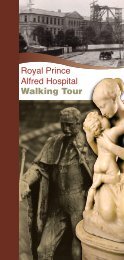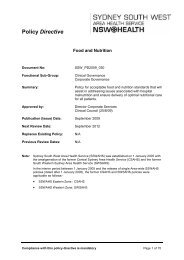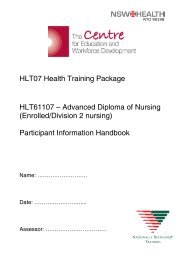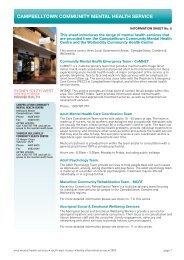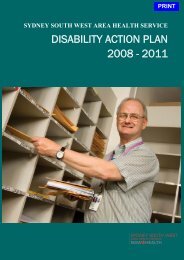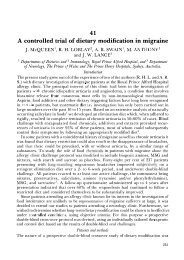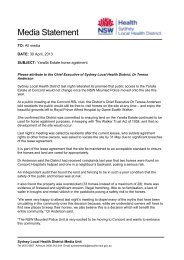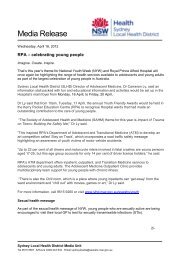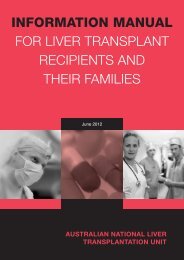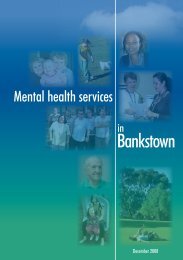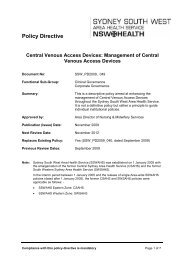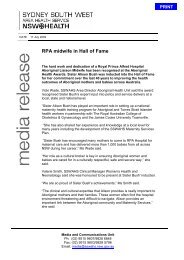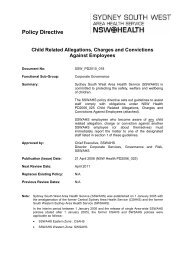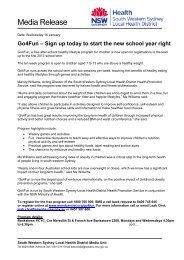Aged Care & Rehabilitation Clinical Services Plan 2007 – 2012
Aged Care & Rehabilitation Clinical Services Plan 2007 – 2012
Aged Care & Rehabilitation Clinical Services Plan 2007 – 2012
Create successful ePaper yourself
Turn your PDF publications into a flip-book with our unique Google optimized e-Paper software.
<strong>Aged</strong> <strong>Care</strong> & <strong>Rehabilitation</strong> <strong>Clinical</strong> Service <strong>Plan</strong> <strong>2007</strong> - <strong>2012</strong>To cater for this increase in demand, staffing numbers will need to be increased commensurate withthe incremental growth in activity. ED bed numbers will also need to be enhanced to cater forgrowth in the older population in each facility.Future Model of <strong>Care</strong>An <strong>Aged</strong> <strong>Care</strong> Service such as ASET should be provided in all hospital EDs. Such a service shouldincorporate multi-disciplinary staffing, to enhance the ability of the service to respond rapidly to theneeds of the older patients, and to establish strong links with community based services. However,it is recognized that not all facilities will have a sufficient number of older people presenting to ED toprovide a full, comprehensive multidisciplinary team. As such, the size and configuration of the teamshould be determined locally, based on demand. At some sites, ED based aged care servicesshould operate extended hours (5pm - 10pm) and weekend days to capture additional patients. Thedemand for this service will need to be determined locally, subject to activity.New models to improve the care of older people presenting to EDs are continually being developedand piloted. Sydney West Area Health Service (SWAHS) Emergency Departments are piloting theOlder Persons Evaluation Review & Assessment (OPERA) Unit model, comprising a dedicated unitfor older people designed to facilitate better processes of care and improved patient outcomes. Inaddition, NSW Health is developing the sub-acute fast track elderly (SAFTE) model of hospitalavoidance for patient ages 75 years and older. At this stage it is not possible to determine theeffectiveness of these models.The <strong>Aged</strong> <strong>Care</strong> and Older Persons <strong>Clinical</strong> Redesign Project will review these models andrecommend strategies to improve the care of older people within EDs. Solutions may includestrategies such as Acute <strong>Care</strong> Triage and Medical Acute <strong>Care</strong> Units (MACUs).Recommendation – <strong>Aged</strong>care <strong>Services</strong> in Emergency TeamsA. Expand existing ASET services to cover extended hours according to demandB. Review existing and develop new models for the care of older people presenting toEmergency Departments.6.1.4 Outpatient Clinics – Geriatric and <strong>Rehabilitation</strong>Outpatient clinics may be medical, multidisciplinary, nursing, or allied health. The range of clinicsavailable varies according to site, and includes general and specialist clinics. Referrals to outpatientclinics come from a variety of sources including General Practitioners, ASET, ACAT and inpatientunits. Access to these clinics may prevent avoidable hospital admissions, enable a reduced lengthof stay through the provision of acute and post-acute care, and provide ongoing support andmaintenance. Some clinic types include wound, cognitive disorders, amputee and continence. Insome facilities, Ambulatory <strong>Care</strong> services complement the outpatient clinic role.Outpatient clinic services are provided at Royal Prince Alfred (RPAH), Concord Repatriation General(CRGH), Canterbury, Bankstown/Lidcombe, Braeside, Liverpool and Camden Hospitals, often withshared infrastructure between aged care and rehabilitation.2005/06 ActivityGiven differences in structure, function and funding sources for the various outpatient clinics acrossthe Area, and differences in data collection and analysis systems, it is not possible to portrayaccurately outpatient clinic activity.Current and Emerging Issues• Population ageing – as the population continues to age rapidly, there will be an increase indemand from older people, particularly frail older people;• Prevalence of dementia – the prevalence of dementia is expected to double by 2016.Particular expertise will be required to assist clients with dementia;• Geriatric medical workforce – some parts of the Area, particularly in the south west, have beenexperiencing difficulties in recruiting geriatric medical staff. As such, there is limited, if anycapacity to provide outpatient clinics from some facilities;• Service access – there are long waiting lists to access certain clinic types and/or particularlocations;Page 40



